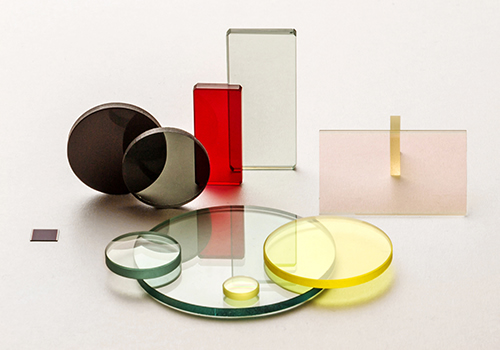p: (262) 548-1155
e: sales@advancedoptics.com
REQUEST A QUOTE
Woman Owned Small Business
Dichroic (Interference) Filters
Dichroic filters or bandpass filters are made of polished optical glass that is coated with multiple layers of dielectric thin films that transmit specific wavelengths of light while reflecting undesired wavelengths at a particular angle of incidence.
Coatings are applied in alternating thin layers of high and low index refraction materials. Light coming into the filter at a specific angle comes in contact with the first index layer and some of the light is reflected and some passes through based on its wavelength which is determined by the index layer. As light travels through these multiple alternating high and low index layers at different speeds, the reflected light either stays in phase (constructive interference) or is reduced by being out of phase (destructive interference) through phase shifts that narrow the final emitted light to a very specific wavelength band. The thickness of the index layers are responsible for the phase shifts and are specifically controlled as well as the number of layers applied to the glass surface to obtain the correct wavelength emitted from the filter.
High and low index layers are often bundled together into stacks (cavities) which are separated by an all oxide layer such as SiO (cavity spacer) which is then followed by a dielectric reflective stack (cavity) that reflects the specific wavelength band produced by the high and low index layers.

Photo credit: Florida State Research Foundation
Unlike absorptive filters which transmit or absorb large wavelength regions, the use of optical coatings described above allow dichroic filters to significantly narrow the wavelength range in which they perform. In fact, dichroic filters with a large number of optical coating stacks (cavities) can narrow the wavelength of light passing through the filter to only a few nanometers.

How to Order Dichroic Optical Filters
Because Dichroic optical filters are a very specialized service, a shopping cart purchase is not available. To request a quote or order optical filters, please fill out our Request a Quote form or call us directly at (262) 548-1155.
Advantages |
Disadvantages |
| Precisely filters specific wavelengths. | High cost. |
| Can be designed to work at any of a wide range of specific wavelengths, can be used to significantly narrow a specific wavelength band. | Angle dependent. |
| Suitable for high power applications. | Less durable than absorptive filters. Care must be taken when cleaning. |
| Hard coatings provide a longer life time than conventional colored glass filters as the color cannot be bleached out over time. | Coatings tend to separate from the glass surface over time when subjected to thermal cycling and humidity. |
| As light is reflected and not absorbed, they are not as heat sensitive as absorptive filters and can be used with higher intensity light sources. |
Dichroic filters can be manufactured from several materials including BOROFLOAT®33, N-BK7®, B270® and fused silica. Substrate selection is based on how well a specific material transmits light in a specific wavelength region. Advanced Optics can precision polish all of these substrates in almost any configuration and provide custom coatings to meet your requirements.
For further technical information and tutorials on dichroic filters please visit: Florida State Research Foundation
Specifying the Correct Optical Filter
Optical filters are classified by their construction, which determines the way they filter light. There are many types of absorptive and reflective filters and careful selection should be based on the specific application in which they will be used. One should consider the following when selecting an optical filter for a specific application: wavelength range of interest as well as cut-on and cut-off properties, AOI of incoming light, energy of incoming light and operating environment.
Whether your application requires an absorptive filter, dichroic filter or neutral density filter, carefully considering your requirements is critical. Specific consideration should be given to the physical size, shape and tolerances of the substrate as tighter tolerances may require additional manufacturing which can add cost. The same applies to the surface quality of the filter which is expressed by a scratch and dig number. The lower the scratch and dig number, the more potential there is for a reduction in yield which drives up the cost of the filter.
Selecting the proper optical filter for your application is essential to saving manufacturing time, which translates to reduced costs. Advanced Optics can help you define your requirements.
